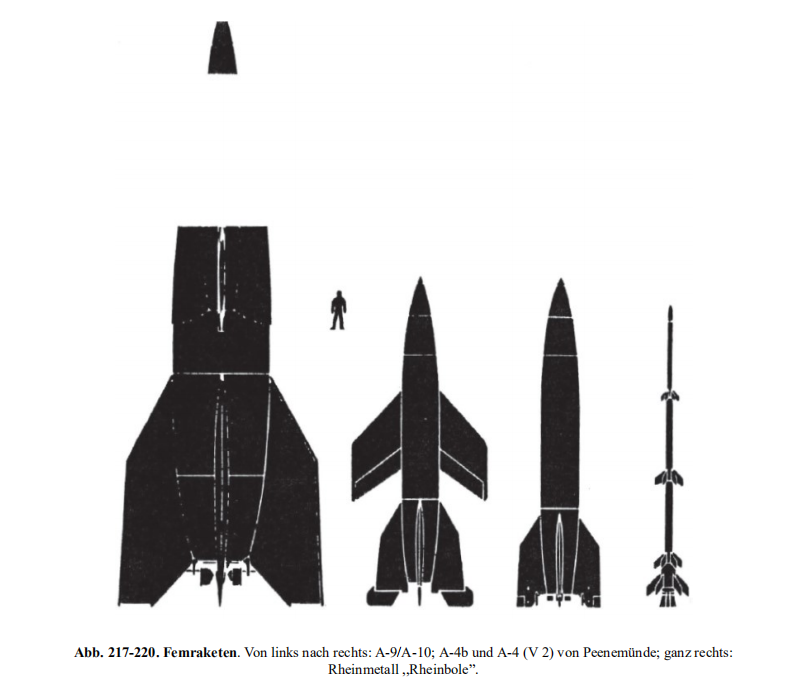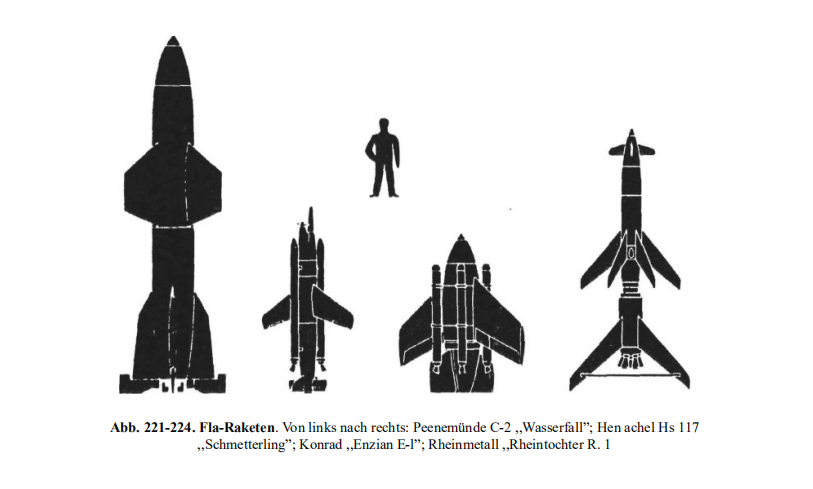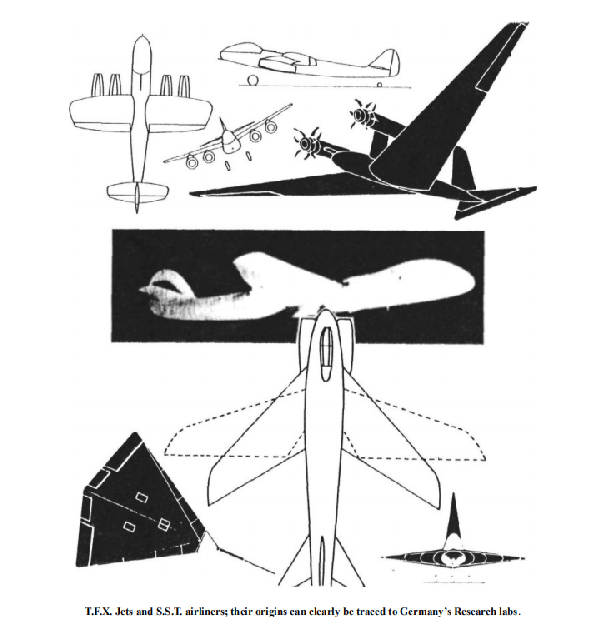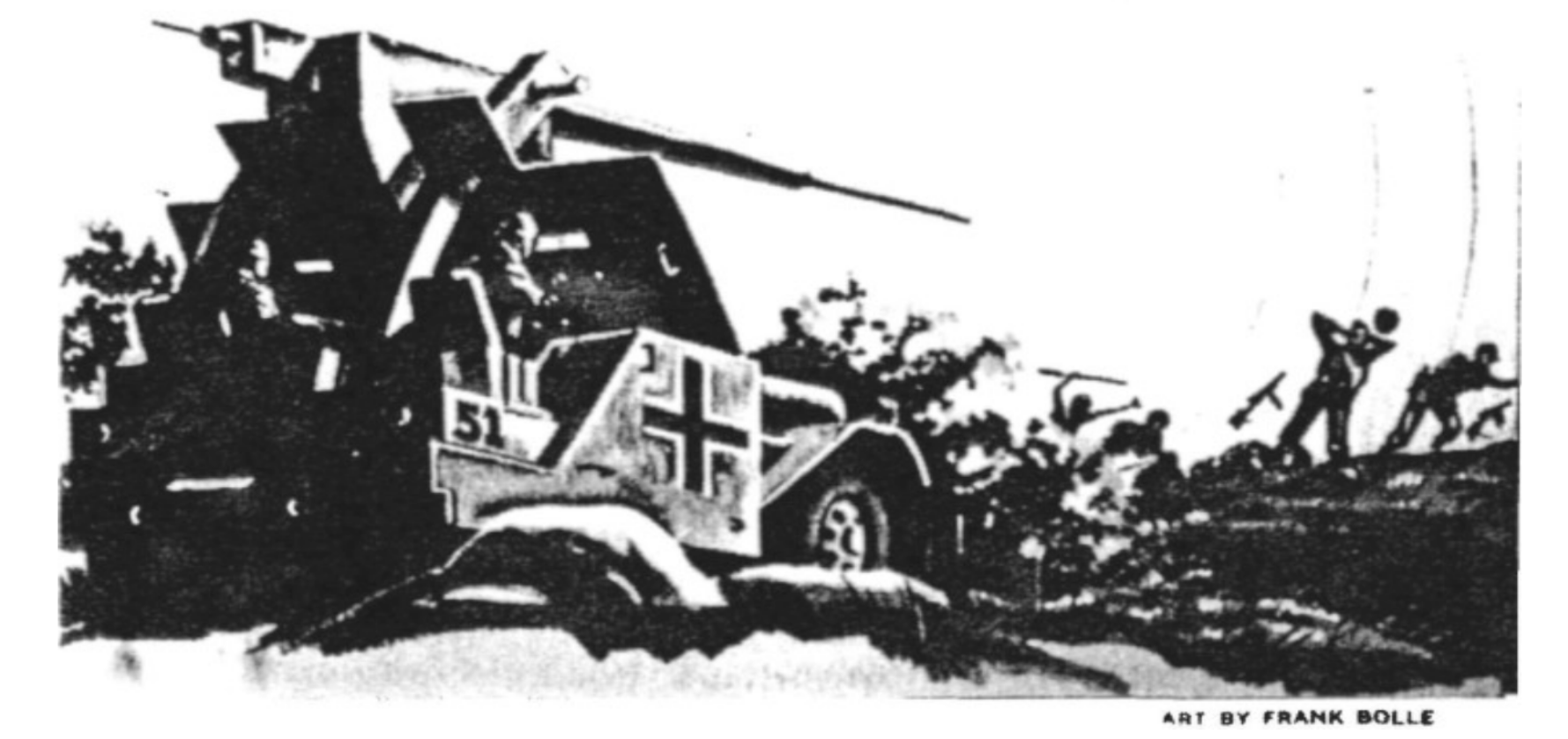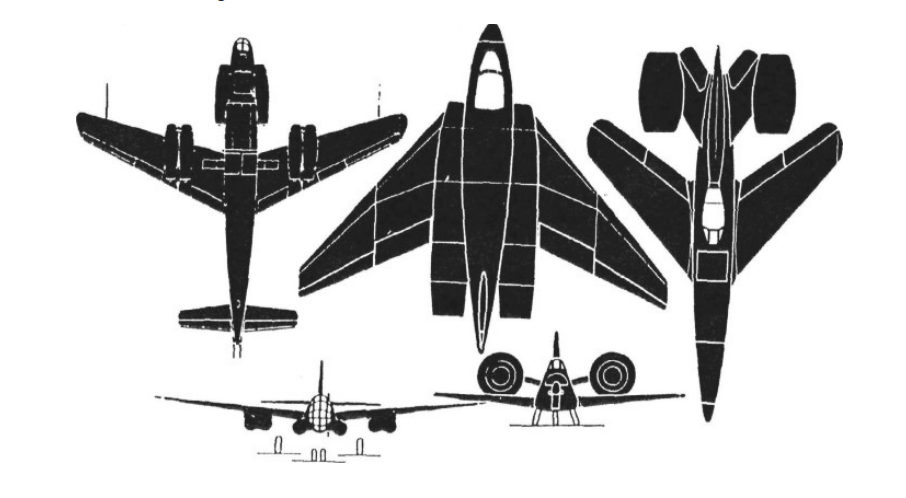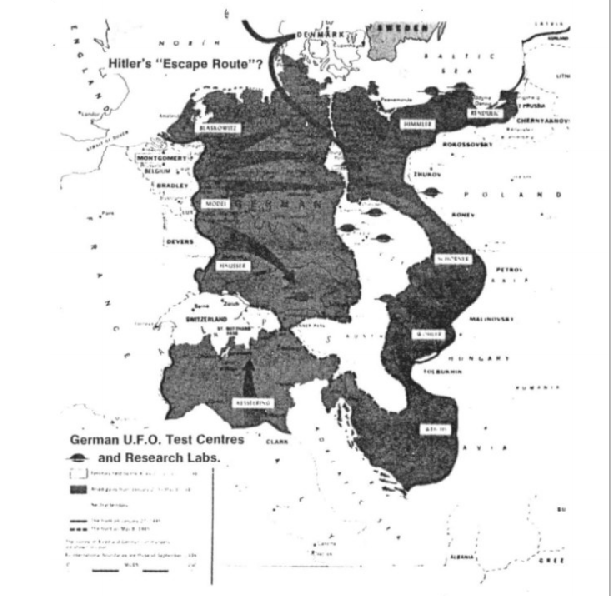P15-29 – from the book ‘UFOs: Nazi Secret Weapon?’ by Ernst Zundel et al
SCIENTIFIC RESEARCH ESPECIALLY IN THE AIRCRAFT FIELD IN N.S. Germany
When Germany sent unmanned guided missiles, in the form of the V.1 and later the V.2 (the V standing for Vergeltungswaffen or Revenge Weapon), crashing into England as payment for England’s,treason against Europe, a weapon was thus introduced to the astonished world that up to that time had only been written about in Science Fiction magazines. Again, the “impossible” had been realised. There was no defence in England against the V.2 and there would have been no defence against the A.9 and A.10 (America Rockets) which were destined to rain on New York and Washington in the Fall of 1945.These rockets were intended as revenge for the aimless and merciless killing of German civilians by the saturation fire-bombing of German cities by the U.S. Air Terrorists.
The breakthrough in the rocket weapon field by Germany so astonished the Allied leadership that Winston Churchill, fearing panic would break out in England,, contemplated germ warfare against Germany. It was only a lack of germs that prevented such action. However, the rocket breakthrough came too late to turn the tide for Germany. Conventional mass-bombing and mass-killing by the Allies took such a heavy toll that the war ended before all the new technology developed by German genius could be brought into the war. It was the knowledge that it was quantity winning over quality that had driven the hopelessly outnumbered German soldiers to despair, and the new technology gave them a feeling of relief plus the knowledge that only for a space of time had mass overwhelmed spirit.
Secret Weapons
General Eisenhower wrote in his book “Crusade in Europe”: “It seems likely that if the Germanshad succeeded in perfecting and using these new weapons six months earlier than they did, our invasion of Europe would have proved exceedingly difficult, perhaps impossible. I feel sure that had they succeeded in using these weapons over a six month period, particularly if he (Hitler) had made the PortsmouthSouthampton (landing) area one of his principle targets, Overlord (the invasion) might have been written off”. Those were the “conventional” V. I and V. II rockets mentioned by Eisenhower with such awe.
Winston Churchill spoke of the “miracle weapons” that Goebbels had promised the Germans, and that if they had come half a year earlier Hitler would have driven the allies out of Europe!
It is interesting to speculate about what weapons these two allied war leaders were referring to.Some were undoubtedly the remote controlled missiles, V.I and V.ll already mentioned. But there were others. There were ground-to-air missiles, some radio-controlled, some heat-seeking, some radar-guided
and others even more sophisticated.
Long Range Rockets (ICBM) The “Amerika Rocket” at extreme left was to be operational byFall-Winter 1945. (Note size of man in relation to size of rockets). Some of the German jet planes on the drawing boards and in the test stage. The experienced observer can trace most “modern developments” to these ancestors. Germany was at least a generation ahead of the rest of the world in “conventional” aircraft design
Flying bombs — remote controlled. See fore-runner of famous U.2 spy plane at top right. All were operational
Abb. 217-220. Femraketen. Von links nach rechts: A-9/A-10; A-4b und A-4 (V 2) von Peenemünde; ganz rechts:Rheinmetall ,,Rheinbole”.Abb. 221-224. Fla-Raketen. Von links nach rechts: Peenemünde C-2 ,,Wasserfall”; Hen achel Hs 117,,Schmetterling”; Konrad ,,Enzian E-l”; Rheinmetall ,,Rheintochter R. 1
Abb. 225-231. Fllegende Bomben. Oben links: Blohm & Voss BV 143; oben rechts: BV 246 B; mitte: Fleseler Fl103 (V 1); unten links: Henschel Hs 293 A-O; unten mitte: Hs 294; untere Relhe rechts oben: Hs 298; untere Relherechts unten: Kramer X-4.
In April 1945, Germany had, in fact, over 130 different types of missiles and rockets. We reproduce here a’ cross-section of the most important types. Please note their size relative to the sizeof a man. All the ones pictured were operational types. Many others were just days or weeks away from combat use. Amongst them were the devastatingly successful R.4-M, air-to-air missiles which were mounted under the wings of an aircraft. A ME-110 could carry 48 R.4M’s and Germany’s new jets carried 24 of these murderously effective weapons.
Luftwaffe Lieutenant Werner Schneider, a German Wing-Commander, flying a F.W.190, attacked on allied bomber formation near the town of Schweinfurth in April 1945 and reported after his landing,“We were about a mile away when we received our directions from the control centre. ‘You are close enough’ a missile expert told us. ‘Hold that range. Just point your noses forward towards them and pull the switches.’ With a hissing sound the missiles blasted away. The result was beyond our wildest expectations. The missiles equipped with proximity fuses, some also with acoustical detonators, sent forty bombers to the ground within minutes.
”Before the war ended, Germany had produced over 20,000 of these missiles of the R4M type in underground factories in the Sudetenland. Allied sources have put bomber losses at the hands of the R4Mto over 500 in a few weeks. However, since aircraft were in short supply at that time, greater emphasis was placed on ground to air missiles. To mention but a few, there are the Enzian (Gentian), Hecht (Pike),Feuerlilie (Firelily), Schmetterling (Butterfly), Rheintochter (Rhine maiden), Wasserfall (Waterfall) and the Taifun (Typhoon). The last one had an acceleration of an incredible 45 G’s.
Wasserfall could reach 50,000 feet and was later improved upon. It was equipped with an infrared guidance system which sent it in a beeline for any Allied bomber — and was 100% accurate. TheButterfly was another step in the V (Vengeance) weapon programme. In April 1945, 3,000 were produced;in June it was to be 10,000 missiles of this type alone.
When V.E. day came around, on May 8th, 1945, many expert analysts amongst the victors expressed the opinion that not a single allied plane would have been able to penetrate the borders of the German Reich after May, 1945. Germany’s defence curtain of anti-aircraft missiles would have been100% fool proof. Not even the atomic bomb would have been able to be “delivered”, not to mention the fact that London and Washington were by that time within range of existing Germany long-range rockets and jet bombers. But there are other weapons to be mentioned here.
There was the “Lafferenz Projects” which was just completed at the time it permitted the firing of missiles from submerged U-Boats. Attacks were planned on cities such as New York, Boston,Philadelphia, Washington and even far-off Detroit.
Tests had been completed using small-scale subs and rockets (Lake Topliz, Austria) and largeV.ll’s towed behind a submarine off Cuxhaven on the North Sea. Then there were flying bombs with builtin computer-controlled T.V. cameras, controlled by pilots who could be hundreds of miles away. There were long-range jet bombers, with 12,000 mile range, jet aircraft — aircraft carriers, transport planes that carried other smaller planes (12 of them) piggyback to their target area and then let loose their cargo of death and destruction. There were ram jets, jet fighters, bombers, transports and there was even an SS Ttransport capable of flying four times the speed of sound.

T.F.X. Jets and S.S.T. airliners; their origins can clearly be traced to Germany’s Research labs.
Also there were passenger jets, a few of which are reproduced here. These plans had already progressed to the stage where models were being tested in the wind tunnels. It is interesting to see that the Americans adopted the German engine mountings on their later aircraft, but most startling of all is the Jumbo jet shown in these pages. Many of the Allied post war developments originated right herein Germany’s laboratories, as is evidenced by the following excerpts photographically reproduced from“America’s Aircraft Year Book,” an official publication. It speaks for itself.
As part of its comprehensive research program to exploit former enemy aeronautical developments, the Air Materiel Command’s Technical Intelligence agency was using the services of some 86 top-flight German aviation scientists of World War II. Working side by side with American military and civilian aeronautical engineers in the laboratories of Wright Field, these German experts were being used, as were tons of captured enemy materiel, documents, blueprints and microfilm,to save American engineers the time they would devote to problems already investigated by the Germans. Their knowledge also helped the Americans to catch up and improve upon Germany’s wartime advancement in such phases of aeronautical developments as rocket and jet power. Similar groups of former enemy technicians were employed in other parts of the country by various branches of the armed forces. At Fort Bliss, Texas, one group was working in connection with research onGerman V-2 rockets and other guided missiles. Others were working with the Army ordnance and engineer experts, and still others were working for the Navy in several fields of applied war research and development.
Among those in the German group at Wright Field were Rudolph Hermann, Alexander
Lippisch, Heinz Schmitt, Helmut Heinrich, and Fritz Doblhoff and Ernst Kugel. Hermann was attached to the Peenemunde Research Station for Aerodynamics, where Germany’s V-2 rockets were hatched and launched against England. A specialist in supersonics, he was in charge of the supersonic wind tunnel at Kochel in the Bavarian Alps. He also was a member of the group entrusted withHitler’s futuristic plans to establish a space-station rocket-refueling base revolving as a satellite about the earth at a distance of 4,000 miles—a scheme which he and certain high-ranking AAF officers in1947 still believed to be feasible.
In order to break down the language difficulties in deciphering captured German documents,prominent educators were working with the AAF in compiling a new 75,000-word German-Englishdictionary intended to clarify German aeronautical terms and phrases. Supervising the project wasDr. Kurt I.. Leidecker, on leave from the Behr-Manning Corporation and Rensselaer PolytechnicInstitute, where he was assistant professor of modern languages and instructor of scientific German.Nearly half the contents of the new dictionary were to be new words. The Germans had nazified aeronautical terms formerly having classic roots, and had coined many new terms not found in any existing dictionary. Material for the dictionary was being extracted from broken enemy codesand from 250 tons of captured German air documents. Considerable value was attached to the widely heralded German ZWB (Central Organization for Scientific Reports) Index which contained important scientific documents. Included were many of the newer aeronautical terms and some applications of older words, which served as an aid to the project translators. Also helpful wereGerman translations of American and British aeronautical terms found in captured documents, and the arbitrary words and phrases applied to German prototypes and equivalents of Allied equipment and accessories.
The German scientists worked voluntarily at Wright Field under special contracts as alien civilian employees of the War Department. Their salaries ranged from $2.20 to $11 a day, and were paid to their banks or families in Germany.
There are other developments never mentioned in any official book, namely the UFO and other
even more devastating weapons. Why is no mention made of them officially? Is it because they were not found? Or that they were destroyed?
However, before proceeding with the UFO’s there are a few more secret developments which must be covered and which, perhaps, you have never heard of before, — the death rays, the sun cannon,Pandora’s Box and the Aeolus Bag.
The Sound Cannon (above)
Once again, we find Hitler steering his scientists towards using nature, not opposing it. He had them harness two important elements, namely the power of the air and the power of the sun.
The first experiments started as early as 1943, on a lonely, rarely-visited mountain plateau inTyrol. For a number of weeks scientists and specialists from the Reichsluftfahrtamt in Berlin (Office of Aeronautics) — of which Major Lusar, who reported about the German UFO programme, was also a member, had been busy setting up a camp, or more appropriately, a base. They were busy unpacking and assembling some odd-looking pieces of equipment. Huge crates arrived by truck from various parts of the Fatherland. Significantly again, many factories which were involved in this project were located underground in what is now Czechoslovakia. When all was assembled, there stood on that lonely, bleak plateau, high in the mist-shrouded mountains of Austria, a most fearsome weapon — the Sound Cannon.(see photograph reproduced here). It looks like a weird longish platform with an angular smoke stack that can be turned into horizontal positions and a fire place or boiler seems to be at the base of it. In actual fact it is a rigid steel combustion chamber in which methane and oxygen can be ignited under high pressure, with the ultimate aim of creating a series of powerful explosions at rapid intervals. The shock waves created by these explosions were to be directed, via the conical smoke stack against any aggressor,with a devastating force. The whole infernal principle was based on the knowledge that the shock waves of sound, generate a certain pressure upon objects which may be in their path. Thunderclaps with their earth-shaking after effects served as the father of thought, in this particular case.
Sonic booms as created by fast and high-flying jet aircraft can, in effect, damage buildings and
burst ear drums. Sound, therefore, if strong enough, can kill. And so the reasoning went behind these tests. Why were they testing this device way up in the Alps? To the peasants below and around, it sounded like a thunderstorm and so created little suspicion.
The scientists had had hundreds of dogs and pigs trained to take the place of attacking Russianinfantry. The animals were trained, Pavlovian style to run in a certain direction for their daily fodder,about 400 yards away. The day the experiment was started, they were once again headed for their troughs.The Sound Cannon had been erected behind some bushes. First came the dogs, then the pigs. There wereno eaters at troughs that day; not one animal survived that 400 yard dash.The dogs came first; at 150 yards distance the first salvo was fired, there was a terrific bang and then followed the shock waves. The dogs stood as if frozen to the ground. Suddenly they let loose a heartrending howl and raced towards the troughs only to be hit by another round. The dogs had come within50 feet of the sound cannon and not one of them survived that second shot. The pigs, still 100 yards awaywere paralyzed for hours. All suffered from disorientation effects, causing them to run helter skelter ineach and every direction. None of them made it to the feeding troughs.
The sound cannon was used operationally against the Russians on the approaches to the Elbe River and against American aircraft close to Passau on the Danube — with the same results. (One wonders did Admiral Byrd suffer the same fate as the pigs when he gave orders to abort that Antarctic overflight after all his orientation instruments went haywire in 1947?).
Illustration shows artist’s conception of the Sound Cannon.
The Aeolus Bag (above)
This New-Age weapon was used to fight off the seemingly endless hordes of Mongolians that
were spewed forth from Asia’s vast steppes. It used oxygen and hydrogen for combustion. The weapon’s function was similar to an air compressor, commonly found on construction sites. If you have ever witnessed the concentrated power of pressurized air from a pneumatic tool or drill you will be able to appreciate the potential impact of the Aeolus Bag. It could stop a truck or a plane dead in its track before disintegrating it.
The Sun Cannon (above)
Very early in the war, the Germans, well-versed in Greek mythology, built another contraption of
note. This silent weapon consisted of a huge truck-mounted mirror able to be rotated at will. The sun’s rays were to be collected, concentrated and sent back towards the sky, blinding enemy pilots and gunners,and so giving to the German fighters very easy pickings. Due to weather conditions over northern Europe,the weapon was seldom used “at home”. However, a member of the Africa Corps reported it used on the ground on some occasions and with excellent results.
Pandora’s Box (above)
When first conceived Pandora’s Box was thought of as an anti-aircraft weapon, but it proved to bemost devastating on the ground. The SS used it against the Jewish, uprising in the Ghetto of Warsaw.The inventor was, in civilian occupation, a mining engineer. He simply re-created the dread of
all coal miners — an underground coal dust explosion. The explosion literally razed any building from its foundations. (See illustration). None of these weapons were ever used by the allies in any of the 50wars since the end of W.W. II. One could safely assume therefore that these weapons did not fall into allied hands, since every other German invention has been reproduced; from missiles to space flight and satellites, and each has been always loudly heralded as some scientific breakthrough by either Russia or Uncle Sam.
This brings to mind a glaring example of the “Brain Drain”. Recently it was announced with great
fanfare that a U.S. paint company had perfected a superb camouflage paint capable of absorbing radar waves or make them unintelligible. They must have either “re-invented” a German invention which had been long in U.S. hands, and probably at great expense to the U.S. taxpayer, or else they just pocketed the money for going through Hitler’s files, for it was nothing more than the paint used on German planes at the end of the war.
There were also other fantastic developments in the purely conventional aircraft design. Reproduced here are a few of the planes on the drawing boards when Germany surrendered. The famousB.M.W. plant in Munich produced for Hitler the world’s first supersonic jet bomber only 12 months after Hitler had requested it. It’s range was to be 10,000 miles. Six jet engines were to give it the speed of sound at an altitude of over 50,000 feet. The plane’s code name, the Horten XVIII, would have been rolling off the assembly lines in the summer of 1945. It was to have carried 8,000 pounds of explosives to Americaand Russia and was designed to give the native population of these continents a taste of what it felt like to be at the receiving end of the “Liberators”.
Hitler was an ardent believer in the teaching of Clausewitz and despite having under his control all of the above advanced technology and the atom bomb, he realised the necessity of having a certain amount of physical force to be able to occupy and control any given land-populated area. This Hitler lacked in April 1945 and hence his strategic withdrawal from Berlin.
Link to original / source article:

